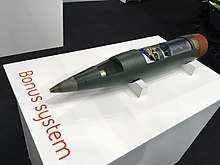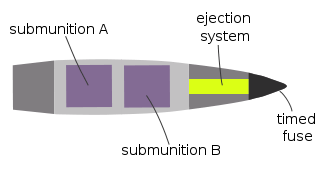Bofors 155 Bonus
155 BONUS is a 155 mm artillery cluster round, developed in cooperation between Bofors of Sweden and Nexter of France, designed for a long range, indirect fire top attack role against armoured vehicles. The BONUS base bleed carrier shell contains two submunitions, which descend over the battlefield on winglets and attack hardened targets with explosively formed penetrator warheads.

Design

155 BONUS is a 155 mm NATO artillery round that consists of a 47-kilogram (104 lb) heavy artillery projectile containing two autonomous, sensor-fused, fire-and-forget submunitions.
After the submunition is released it opens two winglets. While descending, the submunition rotates, scanning the area below with multi-frequency infrared sensors that compares the detected vehicles with a programmable target database. The submunitions each contain a high-penetration EFP warhead for use against even heavy armoured fighting vehicles like main battle tanks.
Operation

| Phase | Picture | Description |
|---|---|---|
| 1 |  |
After setting range and target profile(s), the BONUS round is fired from a standard rifled 155mm artillery tube. |
| 2 | The round flies on a parabolic arc, with a range of up to 35 kilometres (21.7 mi) | |
| 3 | A timer fuse ignites a small ejector rocket in the nose, which drags the two submunitions out of the shell casing over the target area. | |
| 4 |  |
Once clear of the shell, the submunitions fall toward the target. The shell and the nose assembly fall away. |
| 5 |  |
The submunitions deploy winglets, and independently corkscrew down over the subject area with 15 rpm, scanning for targets. |
| 6 |  |
Once a submunition detects a target vehicle beneath it, it detonates its explosive payload, creating an explosively formed projectile which strikes the target vehicle's weak top armour. The high-velocity impactor penetrates the hull and kills or wounds the crew. |
Competing systems
BONUS is very similar to the German SMArt 155 system; SMArt 155 descends on a parachute rather than a system of winglets.
The United States developed the similar M898 SADARM system (which also descended on a ballute to attack the top surfaces of armoured vehicles), but this was discontinued in favour of the GPS guided M982 Excalibur round. US artillery largely deploys the M712 Copperhead laser-guided round for the anti-tank role.
Operators





References
- "Archived copy". Archived from the original on 4 March 2016. Retrieved 1 March 2015.CS1 maint: archived copy as title (link)
- "Archived copy". Archived from the original on 4 March 2016. Retrieved 1 March 2015.CS1 maint: archived copy as title (link)
- "Archived copy" (PDF). Archived from the original (PDF) on 19 April 2015. Retrieved 19 April 2015.CS1 maint: archived copy as title (link)
- Army Concerned Over Ban on Cluster Munitions, Land Mines - Military.com, 2 May 2017
- https://www.baesystems.com/en/product/155-bonus